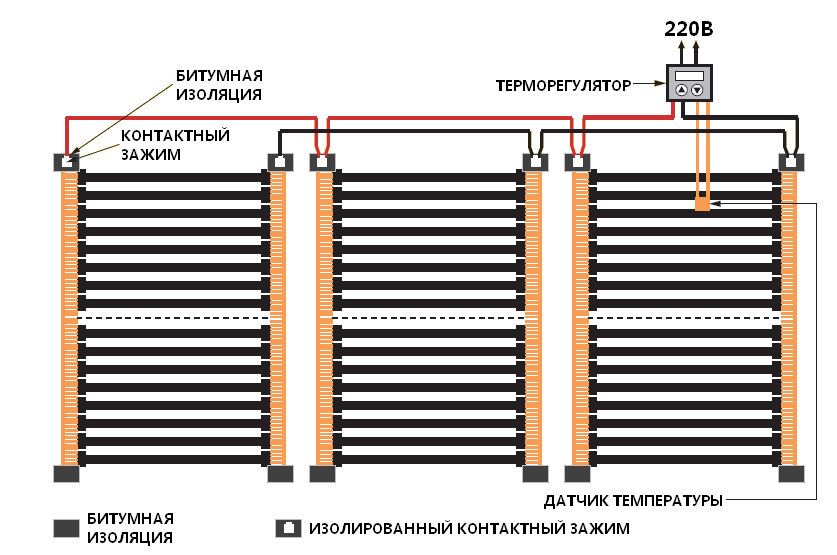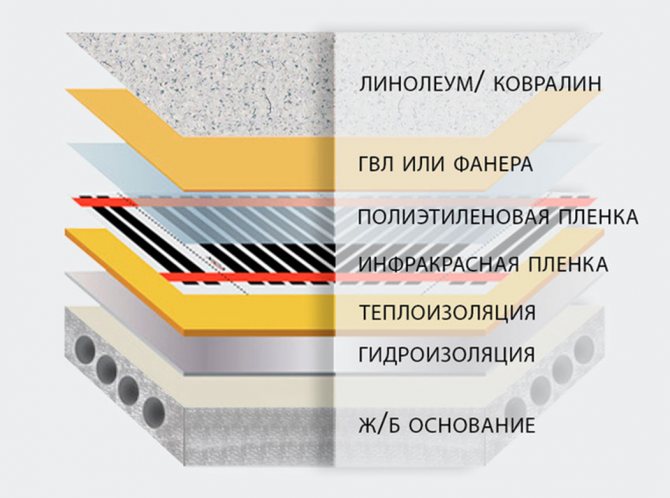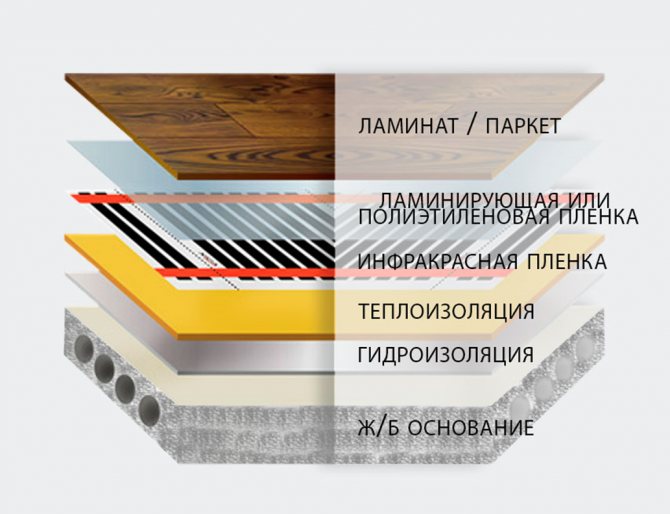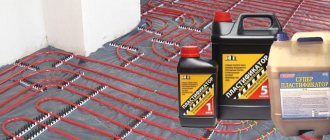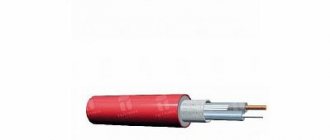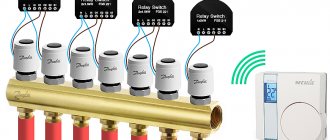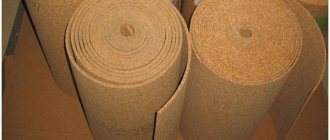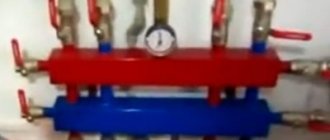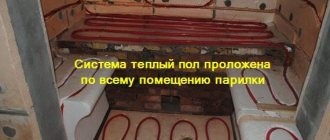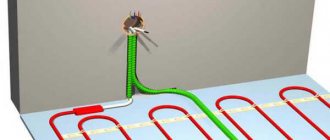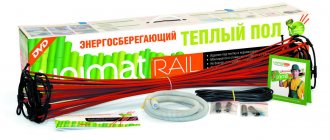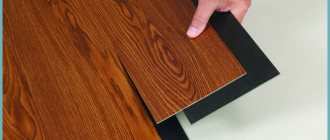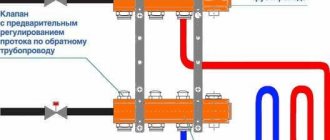Home ›Apartment and country house› Construction and repair ›Warm floor under tiles. Which one is better to choose?
- Installation of underfloor heating under tiles
- Water heated floors
- Installation under tiles
- Electric underfloor heating
- Varieties of electric underfloor heating
- Universal warm floor
- Ultrathin underfloor heating
- Heating section
- Heating mats
- Heating infrared film
- About strengths and weaknesses
- 40 photos of tile ideas for underfloor heating:
To understand what is warm floor under the tiles and choose the right one which is better, you need to get an overview of the types of underfloor heating and installation features. Because the choice of the type and type of underfloor heating is determined primarily by external factors related to the level of the floors, the height of the ceilings, the area and geometry of the room, the possibility of making global repairs.
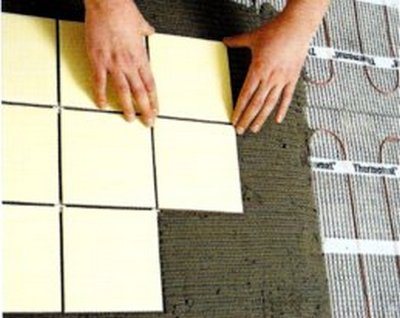
Water heated floors
A pipe system recessed in a cement-sand floor screed with hot water circulating in it is called water underfloor heating. Since it will not heat up by itself, the pipelines are connected to the heat supplier. It can be both an autonomous and a centralized system that provides heat supply.
The warm floor, providing a comfortable thermal regime, is a pipeline made of metal-plastic or polyethylene pipes connected to a temperature controller and a source of heat energy supply.
Flexible pipes with a high coefficient of thermal conductivity have low resistance and provide maximum heat transfer. Almost all of the heat generated is directed outside, heating the concrete screed and ceramic or stone tiles laid on top of it. As a result, the floor surface heats up completely and gives off heat.


Modern water underfloor heating is controlled, and the room temperature is adjusted to the desired one, using a special device. It is called a coolant mixing unit. Therefore, the presence of this element is important to take into account already at the design stage.
System testing
After fixing the line to the floor, the system is tested. It is necessary to check the underfloor heating for leaks. The instruction assumes the following steps:
- A plug is installed on one end of the pipe.
- A tee is connected to the second end. Connect a pressure gauge and a valve.
- A compressor is connected to the valve.
- Air is injected into the pipeline, creating a certain pressure in the pipeline. It is necessary to look at the operating and maximum pressure of the equipment in the technical passport. The pressure gauge controls the mode.
- After the circuit is filled with air, the valve is closed.
- Leave the system for 12 hours.
- If the pressure gauge shows the same pressure level, then the system is in order. If the pressure has decreased, then the tightness of the pipeline is questioned. Air exits through the hole: the process is accompanied by a certain sound. If no sound is heard, then the hole is looked for with water. Bubbles will appear on the surface of the liquid.
We recommend: Is it possible to lay underfloor heating under linoleum?
When performing testing, you must follow the step by step instructions. Otherwise, a line break may occur during air injection. If the results are positive, the system is connected to a comb or to a thermostat.
A test run is carried out. Pressurized water is injected. Allow the coolant to cool down and only then perform the concrete screed. Water is not released from the main line.It is in the pressurized circuit.
Installation under tiles
The device of such warm floors indoors requires a significant amount of repair and construction, installation and commissioning work. First, the old floor coverings are dismantled down to the concrete base. Then determine the floor level.
If the difference is more than ten centimeters, then first the leveling screed is poured, after which, in the order according to the instructions (taking into account the slope, angles of rotation, etc.), pipes are laid through which hot water will pass.
Advice! The thickness of the screed over the heating pipes should not be less than 5 cm. Then the threat of their mechanical damage by dowels at the time of installation work on the installation of plasterboard partitions, fastening of floor equipment is reduced. In this case, pins should be used with a length of 1 cm less than the thickness of the screed.
The next stage is the installation of the coolant mixing unit and the connection of the finished pipeline to the heat source. The final part is laying the floor tiles.
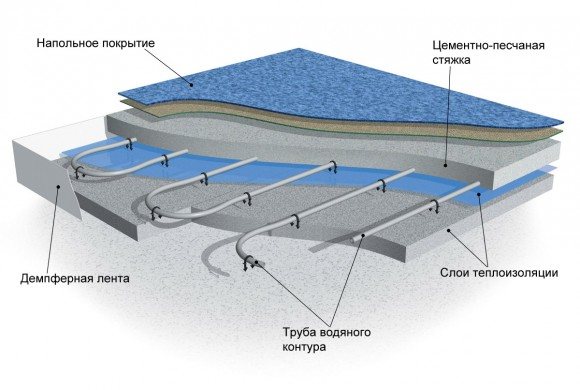

It is difficult to do this work on your own. This requires the skills and knowledge of several construction trades.
Installation, tie-in and connection of a gas boiler, or a direct tie-in to city heating networks requires special approvals issued by authorized regulatory organizations.
If the area is not gasified, it is prohibited to connect to central heating, there is a possibility of flooding the lower rooms or in other similar situations when it is inappropriate to install such a warm floor, you should use floor systems, the heat source of which is electric energy.
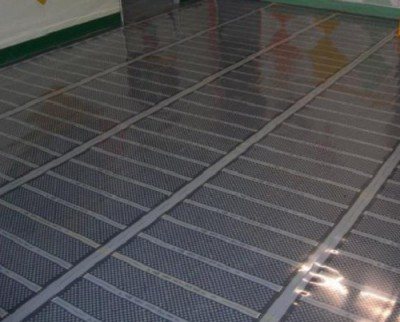

Prepare a rough base
Place the underfloor heating material on a flat surface. It is necessary to build a rough base. To do this, use a concrete screed, self-leveling floor, self-leveling mortar. The surface is insulated, a waterproofing material is laid on it.
When installing underfloor heating, you must follow the instructions. What are the steps involved in preparing a rough base?
- A layer of sand of 10 cm is laid on the ground. It must be tamped.
- Next comes a layer of expanded clay 10 cm. This is the basis for the subfloor.
- The surface is protected from moisture penetration. For this, roll material is used, membranes based on bitumen. Laying is carried out over the entire surface, capturing the walls at a height of 40 cm. Bituminous tape is used for fastening.
- For underfloor heating to be effective, it is necessary to insulate the sub-surface. In this case, the heat will not spread to the foundation or to the ground. All energy is channeled up to the floor. Mineral wool, expanded polystyrene plates are used as insulation: they have locks for connection. Plates are easy to install, if necessary, adjust their size with a mounting knife. The thickness of the insulation depends on the freezing of the foundation. The optimum thickness under normal climatic conditions of the region is 10-15 cm.
- The thermal insulation material is protected from condensation with a polyethylene film. There is no need to strengthen it. It adheres tightly to the coating.
- A damper tape is installed on the lower perimeter of the walls. If there is no adhesive layer on it, then self-tapping screws are used for fastening.
- Concrete screed is carried out. It is recommended to use the M500 brand.
We recommend: How to calculate the power of a warm floor?
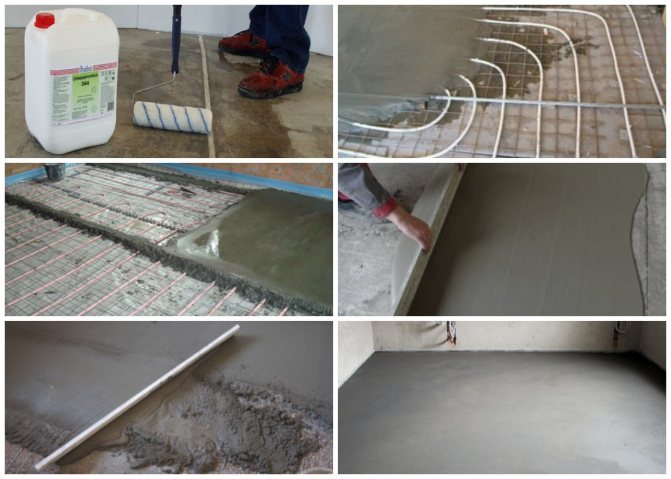

Insulation for roughing is used in cold regions where the foundation can freeze. In regions with mild climatic conditions, it is enough to isolate the base from moisture and fill it with concrete. In the future, the steps to form a rough floor for a warm floor are repeated: waterproofing, insulation.
As protection against moisture, it is not recommended to use materials based on bitumen. When heated, it emits toxic fumes.The concrete surface and part of the walls are covered with mastic and a primer with moisture-repellent properties.
Insulation, polyethylene film and a reflective screen are placed on the prepared coating; This is a 3-5 mm thick foil substrate. The material allows heat to be directed to the floor.
The preparation of the rough coating involves several layers of waterproofing. They protect the foundation, insulation, concrete screed from the effects of condensation, which forms due to temperature extremes. The material is not protection against flooding in emergency situations in the liquid floor line.
Electric underfloor heating
This type of heating is safe to operate and easy to install. It can be used to organize main or additional heating.The variety of types of electric underfloor heating allows you to mount them at any stage of construction and repair, as well as during the operation of the premises. It all depends on the need, feasibility, power and desire of the owner of the premises.
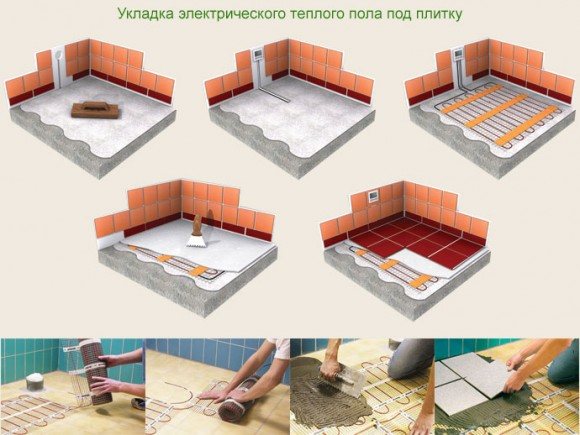

Electric underfloor heating is an integral closed space heating system. It includes elements that convert electrical energy into heat, a power cable for supplying electricity, temperature sensors and thermostats.
Important! In order for the system to work effectively, it is necessary to make accurate calculations, prepare a project or scheme. This can only be done by a qualified technician. Correct installation and professional setup are equally important.
Heat is a delicate matter. Heat insulation of a warm floor. Ultrathin underfloor heating
Home ► Our articles ► Heat is a delicate matter. Heat insulation of a warm floor. Ultrathin underfloor heating
How to provide thermal insulation (heat insulator) when installing a "warm floor" system?
Laying of thermal insulation is necessary in cases where there is a cold room below or there are local cooling zones (unheated basement, ground, etc.). Cases of installation of cable heating systems on balconies and loggias require special attention. The use of heat-insulating material allows to reduce energy consumption. It is important to install both horizontal and vertical insulation between the floor and the cold outer walls, which prevents heat loss at the joints. It is recommended to use certified products with sufficient mechanical strength as thermal insulation materials: cork agglomerate, extruded polystyrene foam, expanded clay backfill. In order to avoid overheating of the heating cable, it is necessary to make a preliminary tie (minimum thickness) between it and the thermal insulation or lay the cable on a metal mesh (with a cell of 2-5 cm). In this case, the screed, poured in one step, turns out to be monolithic, with a reinforcing frame. The experience of our company's specialists shows that the widespread thin (2-5 mm) foam foam substrates with foil for heat reflection are in fact ineffective. The fact is that soft penofol, being pressed down by the weight of the cement screed and floor covering, decreases in thickness and its thermal insulation properties deteriorate significantly. In addition, such thermal insulation reduces the mechanical strength of the screed by separating it from the floor slab. If, for connection with the massif, cutouts are made through which the cement screed is mechanically bonded to the slab to achieve a solid structure, "cold bridges" are formed.
What are the advantages of an ultra-thin underfloor heating?
Ultrathin floor is one of the types of warm floor, which is very popular abroad, and recently in Russia. This is the most advanced development of all existing electric heating systems. It surpasses conventional single-core and two-core systems in several respects: 1. Ultra-thin warm floors are installed without "wet" processes.They are sold as pre-assembled mats that do not require assembly. They are laid out on the surface and are not poured with concrete, but immediately laid on top of the floor covering. Thus, installation time is noticeably saved (before, when pouring with concrete, it took 3 weeks only for drying). 2. The decision to install ultra-thin underfloor heating can be made at any stage of construction and arrangement, even after the repair is completed, while it is recommended to install a conventional underfloor heating at the stage of rough finishing - before builders begin to remove the floor level. If the floor has already been taken out (on the same level with the door), then it may be inconvenient to install a conventional underfloor heating system, since as a result of this, a screed 3-5 cm high will appear, forming a threshold in the room. To maintain a uniform floor level, ultra-thin systems are used. 3. Warm floor in the form of mats is a reliable solution. You can buy them yourself, since the specific power of the equipment is calculated with a small margin - you won't miss. The installation process does not require highly skilled installation: it is almost impossible to do something wrong. In operation, such mats have already confirmed their reliability, but if something goes wrong (for example, builders accidentally drill the floor and damage the mat), it will be much easier to fix it than in the case of a warm floor that is poured with concrete. The floor covering at this point is opened and the damaged part is replaced. 4. Ultrathin underfloor heating at a price comparable to a conventional one. If the cost of a qualified installation together with the cost of a screed is added to the costs of an ordinary warm floor, the price will be quite comparable to the more expensive, at first glance, ultra-thin system. 5. New technology is not afraid of overload. The use of a new material in the structure - fluoroplastic - creates a margin of safety against overheating of the system. For example, if a fur coat accidentally falls from a hanger on a regular warm floor in heating mode and lies on it for several hours, the system will overheat. A warm floor in the form of mats will take such a "test with a fur coat" easily.
6. Ultrathin warm floors fit easily into construction technology. When installing a conventional warm floor, you need to decide before pouring where and how the furniture will be located, what size the carpet will be. At the stage of rough finishing, such details are difficult to predict. Installing an ultra-thin underfloor heating allows you to postpone these decisions until the stage of finishing (laying the floor covering). All these advantages make ultra-thin underfloor heating a universal, most convenient and comfortable way of heating.
tepm.ru
Varieties of electric underfloor heating
In the construction market of the country there is a large selection of all kinds of electric floors, so their installation under the tiles is possible in any room. To select the most suitable ones, you need to know the technical features and have at least a minimal idea of the specifics of the installation of each type.
The principle of electric underfloor heating is that the supply cable supplies electricity to the heating cable, which, in turn, converts it into heat. Temperature sensors located in the room transmit information about the room temperature to the thermostat, and based on the received data, it stops or restarts the power supply to the system.
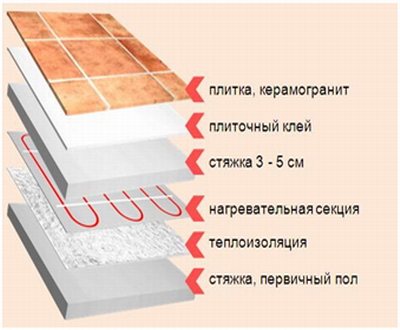

Heating cables are of two types: single-core, which have practically ceased to exist, and two-core, which have firmly taken their place. They are fundamentally different.
Single core cables create an electromagnetic field. And, although its values are within acceptable limits that are not harmful to health, the installation of systems with such a cable is not recommended in rooms where a person spends a lot of time.
A two-core cable for underfloor heating does not generate an electromagnetic field and can be installed in rooms for long-term stay of people: in bedrooms, offices, classrooms. The installation of a two-core cable can be stopped anywhere, based on the length of the section, but systems with single-core cables are mounted in such a way that the beginning and end of the heating cable must be at the same point.
A novelty on the heating system market is a self-regulating cable. In conventional systems, cables are heated evenly along their entire length, so when installing them, areas for furniture sets, bookshelves, wardrobes, beds and other stationary furniture must be free from cable routing. Furniture rearrangements in such rooms are often impossible. Even transferring the carpet from one part of the floor to another will become problematic, since if you lay it in the place where the heating cables pass, they will overheat and fail.
Recently, such inconveniences can be avoided due to the self-regulating cable, which is heated unevenly. The special technological design allows him to independently lower the temperature in any area.
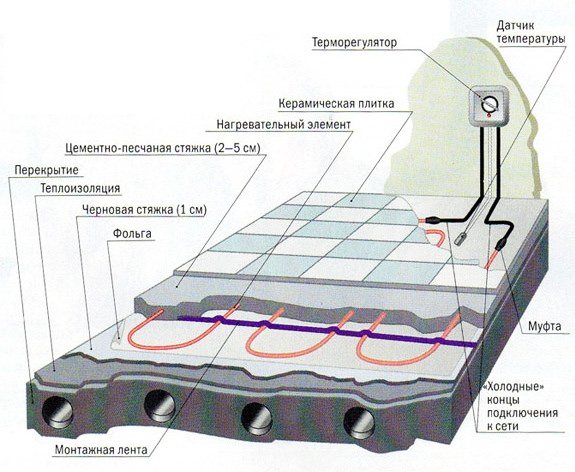

Different types of warm electric floors are manufactured in one configuration or another. The choice of this or that option is based on the need to change the floor level. Power, dimensions, reliability and technical characteristics depend on the manufacturer.
The device and scope of infrared underfloor heating
The heat carrier in infrared floors is a two-layer film with emitters sealed between two layers.
They are connected in parallel, so if one emitter fails, the device continues to work properly. The main advantages of this method of additional heating of the room include the following:
- Warm-up uniformity.
- More efficient use of electricity and associated resource savings.
- Overcooling or overheating of the heating system and the room is excluded.
- Dustiness of the atmosphere is reduced.
- No maintenance required.
- The oxygen in the air does not burn out.
- The heaters do not affect the humidity in the room.
- Ease of installation.
Devices of this kind are increasingly being used both for industrial premises and in housing construction for a variety of purposes. This can be heating equipment or containers with liquids, additional heating in extreme situations, or heating the floor to create a comfortable living environment.
Heating infrared film
Suitable where rough finishing work has been completed. The film is laid directly under the laminate, tiles and even linoleum. It is produced in rolls, in which cutting lines are provided at certain distances, or in separate mats.
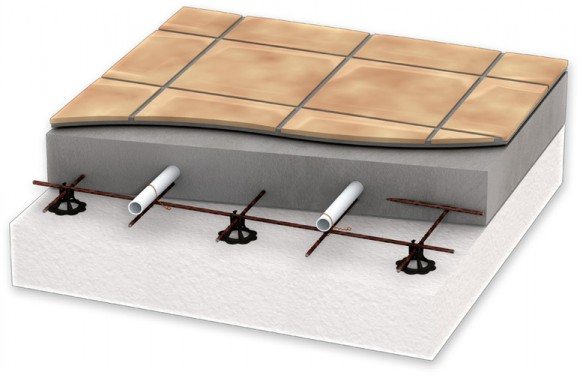

This floor will fit under the tiles in bathrooms. In these rooms, where the infrared floor is switched on for a short time, it is quite possible to do without a thermostat.
Attention! Some types of infrared floors cannot be installed under tile adhesive or screed.
Advice! If in the room where it is planned to assemble the underfloor heating system, the finishing finish is completed, the correct solution would be to install an infrared film.
About strengths and weaknesses
The question of choosing a warm floor for tiles is far from unambiguous. Everyone decides it for himself. Therefore, mention should be made of the advantages and disadvantages of underfloor heating.
Advantages of a water-heated floor:
- relatively low cost of the coolant;
- low installation cost if connected to central heating.
Disadvantages:
- with a screed, it is easy to damage the pipelines, and it is almost impossible to notice;
- for efficient operation of the system, a circulation pump is used;
- installation in apartment buildings is prohibited in many regions; a special permit is required for installation.
An electric underfloor heating is much simpler from the point of view of the possibility of its device, regardless of the type, purpose and occupancy of the room. But he is not perfect either.
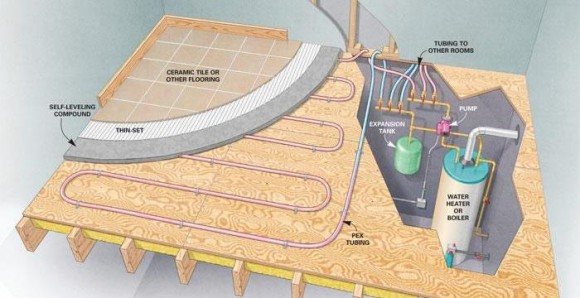

Benefits of electric underfloor heating:
- long service life (up to 50 years);
- low power consumption when working properly;
- tolerance of negative temperatures in the room, at rest.
Disadvantages:
- in rooms with a large area, two or more systems are assembled into one;
- single-core cables create a negligible electromagnetic field.
The advantage of each type of underfloor heating is the absence of convective drafts. This means the same temperature in any part of the room (vertically), no dust floating in the air. Well, in addition, a warm floor is a pleasant sensation, comfort and convenience.
Types of structures and their fields of application
Several varieties are produced under the Teplolux brand warm floors.
Cable systems
The company produces 4 basic models in various modifications using single-core and two-core conductors:
- Green Box. Electric warm floor on a reel (to simplify laying) is used under tiles in areas of complex configurations and layouts. The product is reliably protected by a special copper braid shield. Installed in a tile mortar.
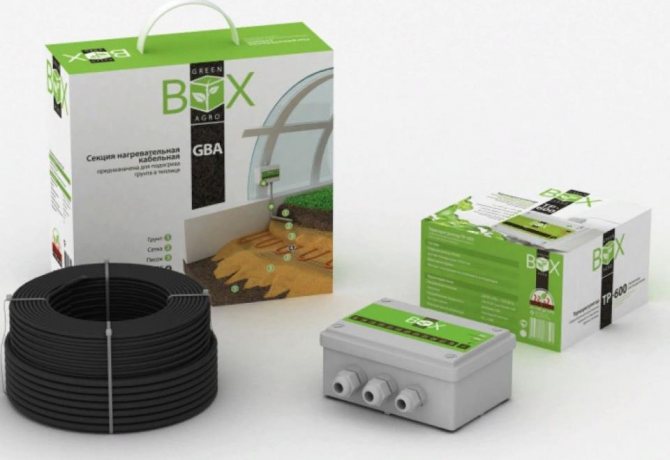

- Profiroll. Has a lifetime warranty period, intended for rapid heating of unheated areas. The line has 18 sectional standard sizes, and therefore is convenient for selecting a conductor of the required power. The thickness of the cable conductor is 5.7-6.5 mm. High-quality protection of the conductor and tightness of connections is provided by a special coupling. The circuit is versatile, practical and reliable.
- Standart. It is an additional heating circuit that can heat up to 30 sq. m area. Available in single-core and two-core versions. The scheme is intended for residential, office and industrial premises. The diameter of the conductor is approximately 3 mm, which does not lead to a significant increase in the floor of the ceiling during installation.
- Elite. It is used as the main variant of heating, in which a two-core shielded cable is used. Installed under any type of flooring. Not recommended for rooms with high humidity levels.
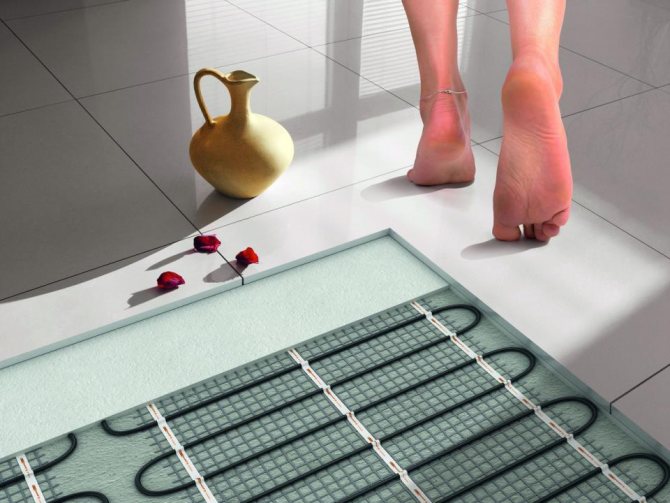

The company has also developed a series of heating devices, classified according to the characteristics of the intended purpose:
- Mini. Single conductor systems for heating small spaces. Thin underfloor heating makes it possible to reduce the height of the screed to a minimum. Installation is simple: the heating mats are cut into pieces of the desired size, then the floor is lined with them. The connection is provided without additional electrical wiring. The maximum power is 150 W / m.
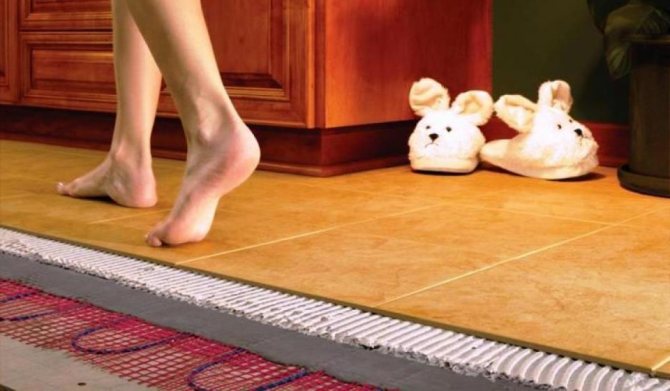

- Tropix... Floor 3 mm thick with 2-core conductor. It has a large heat transfer and a significant heating area. Installed on a mesh with an adhesive base.
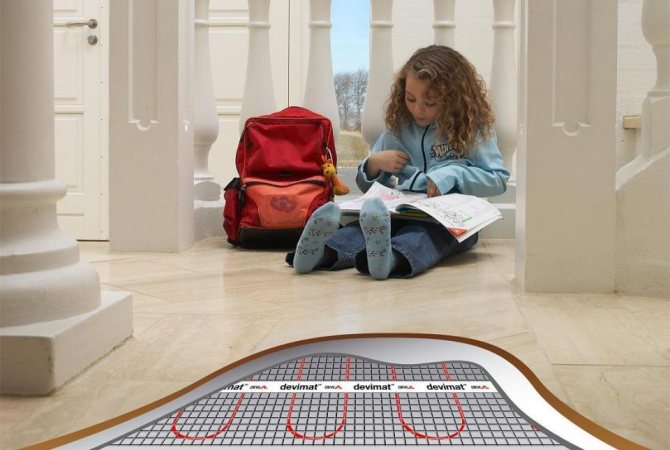

- Profi. The floor with a two-core conductor, made in the form of a mat, is reliable and easy to use.
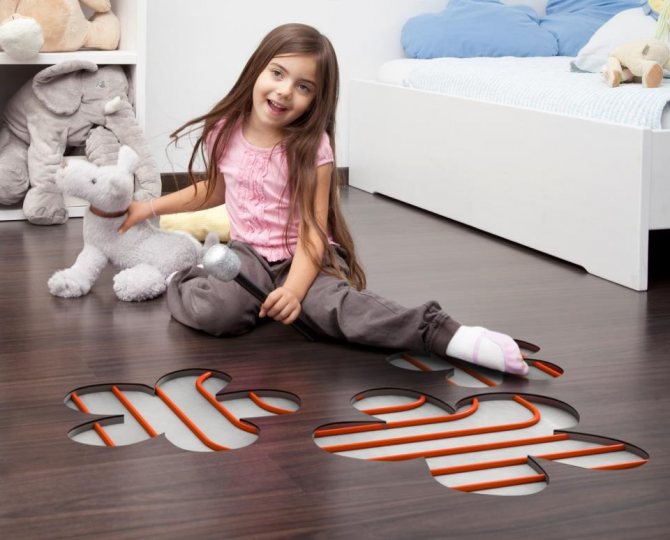

- Express - mobile system. It is laid under a dry coating (linoleum, carpet or parquet). It is a thin film (about 1 mm in thickness).
Heating mats
Heating mats easy to install and operate, do not require calculations. It is enough to unfold them, arrange and secure them with special glue or a screed.
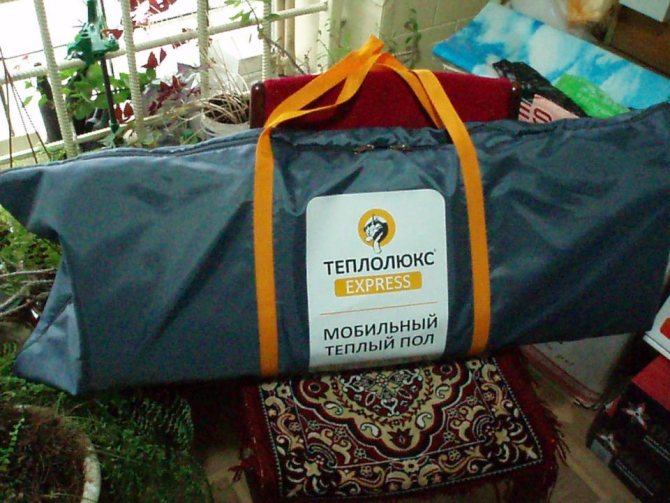

These products are made in two basic modifications, differing in their characteristics:
- ProfiMat. A circuit with a two-core conductor fixed to a protective glass mesh. The product is mounted in a screed. Universally applicable.
- Tropix. A very common heating scheme with a capacity of 200 W / sq. m is capable of heating unheated areas. The area of application is wide: the system can be installed even in swimming pools and saunas. The productivity of the product is maintained at a temperature of -10 degrees.
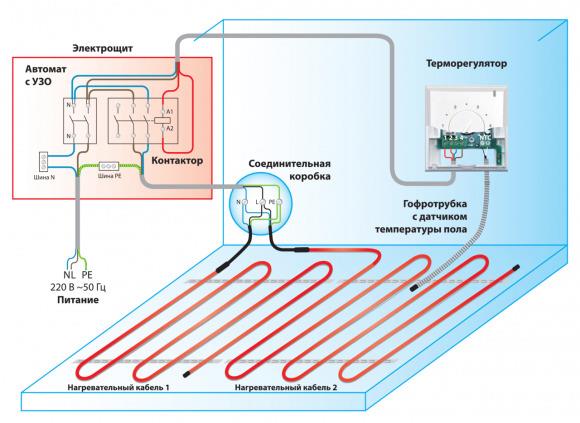

Infrared (IR) film warm floors
The principle of operation is based on the use of infrared radiation, which heats the surface of the objects placed on top of the system.
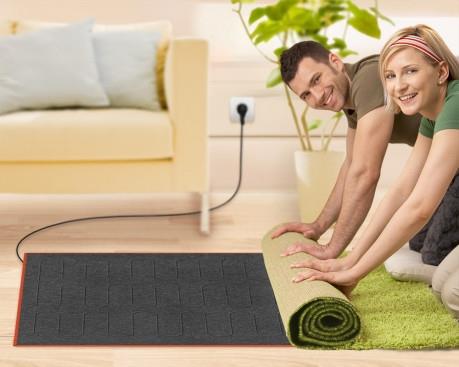

Several modified Slim Heat series are produced, differing in technical parameters:
- IR film floors with a 0.34 mm film of two types: with a performance of 150 or 220 W / sq. m, intended for heating areas from 1 to 10 sq. m. Laying under parquet is allowed. It is unacceptable to mount in a screed. They can be used as a basic heat source. The set of the product includes a control panel, a temperature sensor, and connection terminals. The scheme is suitable for residential and office premises, as well as areas with significant heat loss;

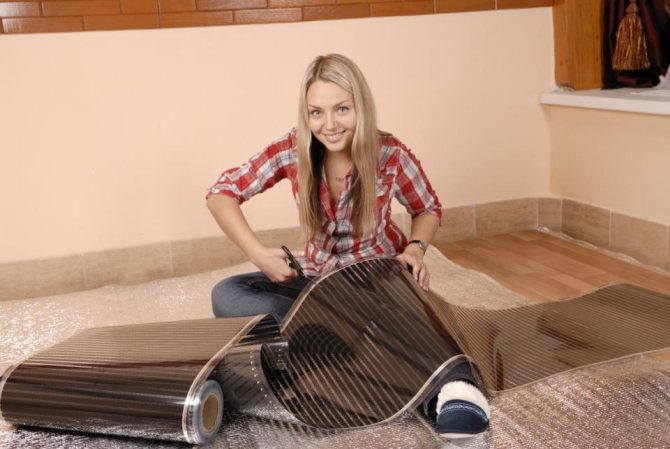
- Express mobile floors. Contains a thin heating conductor embedded in a nylon carpet. These rugs are laid on top of the floor covering. Products are conveniently rolled up and easily carried. They are capable of heating the heated area to a temperature of 30 degrees in one hour.

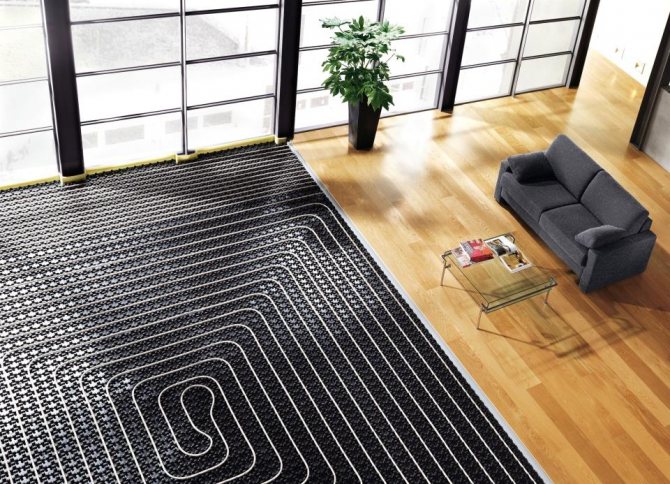
All types of Teplolux products are equipped with reliable protection against fire and electrical surges. The warm floor is laid under the tiles, porcelain stoneware, laminate.
